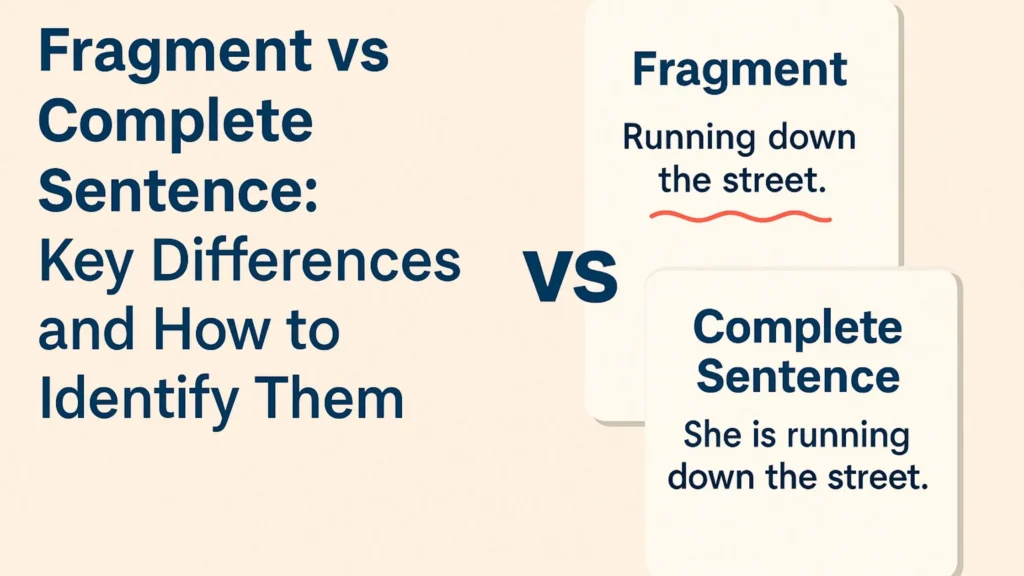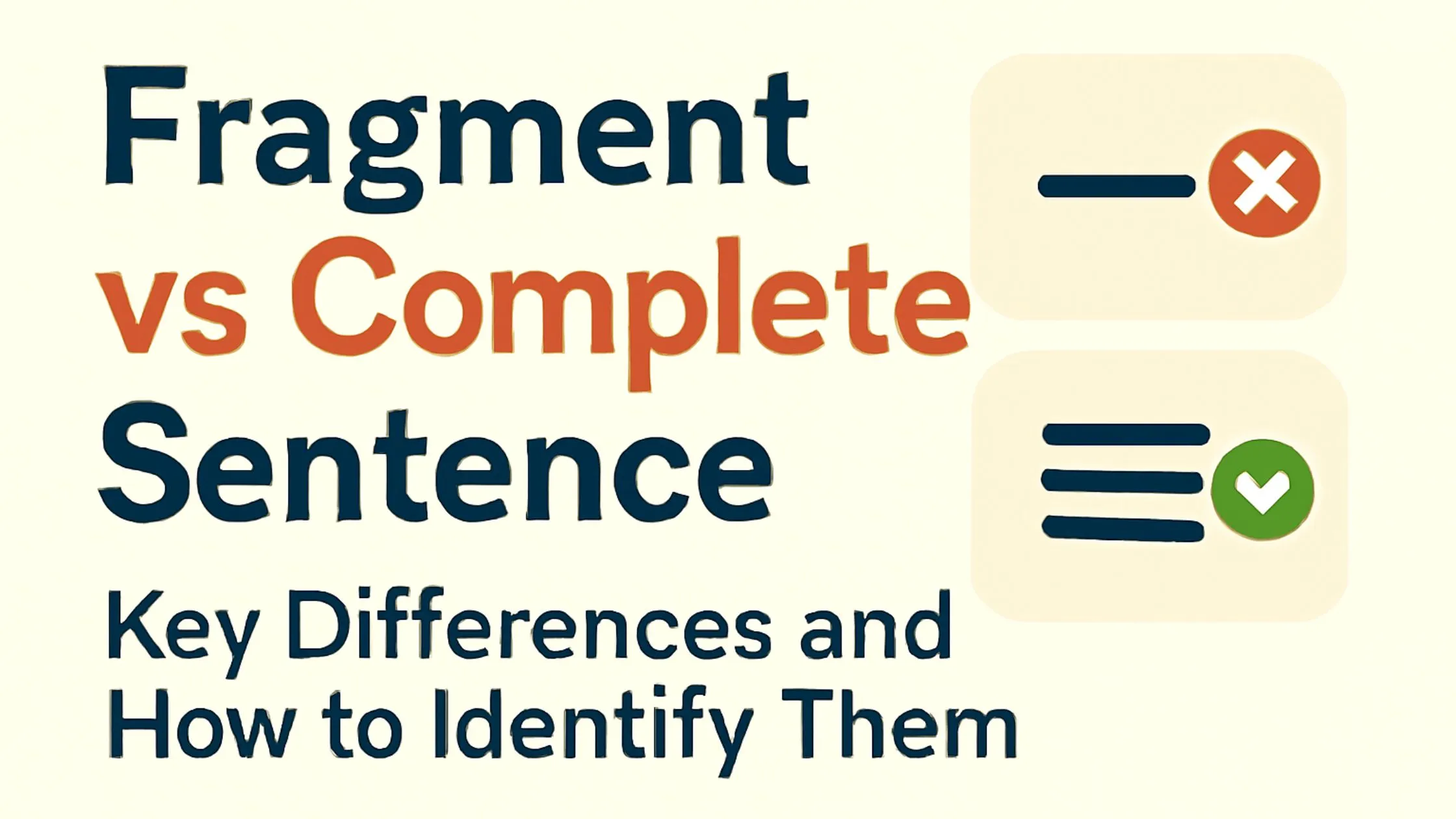When it comes to writing, understanding fragment vs complete sentence is crucial for effective communication. Sentence structure plays a key role in how ideas are conveyed, making it important to know the difference between fragments and complete sentences. A fragment is an incomplete thought that leaves readers hanging, while a complete sentence expresses a full idea with both a subject and a verb.
Mastering sentence structure is essential for clear, concise writing. Whether in academic essays, business communications, or casual writing, using complete sentences helps ensure the message is understood. By learning how to identify and fix sentence fragments, writers can enhance the flow and readability of their content. Understanding these key elements of sentence structure will significantly improve writing skills and overall communication. It also used to understand the languages.
What is a Fragment vs Complete Sentence?
Understanding the difference between fragment vs complete sentence is essential for clear communication in writing.

Fragment Sentence
A fragment is an incomplete sentence that lacks key components, such as a subject or verb, making it unable to express a full thought. Common characteristics of fragments include missing subjects, verbs, or incomplete ideas. For example, “Running down the street” is a fragment because it doesn’t form a complete thought.
Complete Sentence
On the other hand, a complete sentence is a fully formed idea that includes both a subject and a verb, expressing a complete thought. An example of a complete sentence is, “She is running down the street.” A complete sentence can stand alone and make sense to the reader. Knowing the difference between fragments and complete sentences is crucial for improving writing clarity and readability.
Key Differences Between a Fragment and Complete Sentence
When discussing fragment vs complete sentence, there are several key differences that writers should be aware of to ensure clarity in their writing.
Lack of a Complete Thought
A fragment fails to express a full idea or thought. It leaves the reader with an incomplete understanding. For example, “After the meeting” is a fragment because it doesn’t explain what happens after the meeting. On the other hand, a complete sentence conveys a clear, full thought, such as “After the meeting, we went for lunch.”
Structure
The primary structural difference is that a fragment often lacks a subject or verb. For instance, “Running quickly” lacks a subject, making it incomplete. A complete sentence has both a subject and a verb, creating a clear structure.
Grammar and Punctuation
Fragments may contain incomplete clauses or missing punctuation, while complete sentences follow proper grammatical rules and punctuation, forming independent clauses that can stand alone.
Common Examples of Fragments and Complete Sentences
Understanding fragment vs complete sentence through examples can help clarify the differences and improve writing.
Examples of Fragments
A fragment is an incomplete sentence, often missing essential elements like a subject or a verb. Here are some examples of fragments:
- “Running down the street.” (Missing a subject)
- “After the meeting.” (Lacks a complete thought)
- “Because I said so.” (Doesn’t express a full idea)
Each of these examples leaves the reader asking, “What happened next?” This lack of a complete thought makes them fragments.
Examples of Complete Sentences
A complete sentence expresses a full, clear idea with both a subject and a verb. Here are some examples:
- “She is running down the street.” (Has both a subject and a verb)
- “They went to the store after the meeting.” (Fully formed thought)
These sentences stand on their own and convey clear messages, making them complete sentences.
How to Identify a Fragment vs Complete Sentence
Identifying fragment vs complete sentence can be easy once you understand the basic components and structures. Here’s how to spot the difference:
Identify the Subject and Verb
The first step in identifying whether a sentence is complete is to look for a subject and a verb. A complete sentence will always have both. For example, in the sentence “She runs fast,” “She” is the subject and “runs” is the verb, making it complete.
Recognizing Common Fragment Types
Fragments often come in different forms:
- Dependent Clauses: These start with words like “because,” “if,” or “when,” but don’t express a complete thought. For example, “Because she was late” is a fragment.
- Phrases Without a Subject: These can include just actions or descriptions, such as “Running quickly,” but lack a subject to make it complete.
Punctuation Tips
Punctuation is another key indicator. A fragment might lack proper punctuation, like missing periods or commas incorrectly placed, making it look like a complete sentence when it’s not. Always check if punctuation signals the end of a thought.
How to Fix a Fragment and Make It a Complete Sentence
When dealing with fragment vs complete sentence, fixing fragments can be easy with a few simple steps.
Adding a Subject or Verb
To turn a fragment into a complete sentence, it’s essential to add the missing subject or verb. For example:
- Fragment: “Running down the street.”
- Fixed: “She is running down the street.”
By adding the subject “She” and the verb “is,” the fragment becomes a complete thought.
Combining Fragments with Other Sentences
Another way to fix a fragment is by combining it with a complete sentence. For example:
- Fragment: “Because it was raining.”
- Complete Sentence: “We stayed indoors because it was raining.”
By joining the fragment with a full sentence, you create a smooth and grammatically correct structure.
Examples of Fixing Fragments
- Fragment: “While going to the store.”
- Fixed: “I saw him while going to the store.”
These simple fixes can help turn incomplete thoughts into clear, effective sentences.
Why Understanding Fragments vs Complete Sentences is Important for Writing
Understanding the difference between fragment vs complete sentence is crucial for clear and effective writing. Here’s why:
Enhancing Clarity
Mastering sentence structure improves the clarity of writing by ensuring that each sentence expresses a complete thought. When writers avoid fragments, their messages are more precise, and readers can easily follow the content.
Improving Readability
Eliminating fragments leads to smoother, more readable sentences. Complete sentences flow better, making the writing more enjoyable and less confusing for the reader. This is especially important when writing long pieces where clarity is key.
Impact on Academic and Professional Writing
Correct sentence structure is essential in academic and professional settings. Fragments can make writing seem disorganized and unpolished, which could negatively impact the reader’s perception. Whether it’s an essay or business communication, using complete sentences adds professionalism and credibility to the work.
FAQ
Q: Can a sentence be a complete thought without a subject or verb?
No, a sentence cannot be a complete thought without both a subject and a verb. These two components are essential for expressing a clear idea. Without them, the sentence is considered incomplete or a fragment.
Q: How can I avoid writing sentence fragments in my own work?
To avoid sentence fragments, ensure each sentence has a subject and verb. Be mindful of dependent clauses that need to be paired with an independent clause. Always check your writing for incomplete thoughts and use punctuation properly to separate full ideas.
Conclusion:
Understanding the difference between fragments vs complete sentence is essential for clear and effective communication. Recognizing and fixing fragments ensures that writing is precise, readable, and professional.
Writers should regularly practice identifying and correcting fragments to strengthen their writing skills. This simple habit can significantly improve the flow and clarity of their work.

